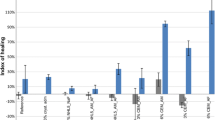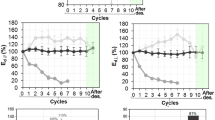Abstract
Mortars are known for their ability to heal their defects in an autogenic way. This phenomenon is expressed by the filling of microcracks by secondary products, restoring or enhancing the material’s performance. Parameterization of self-healing phenomenon could be a key factor for the enhanced sustainability of these materials in terms of reduced repair cost and consumption of natural raw materials and thus reduced environmental fingerprint. The fact that this phenomenon takes place autogenously suggests that the material can self-repair its defects, without external intervention, thus leading to a prolonged life cycle. In the present study, the autogenic self-healing phenomenon was studied in natural hydraulic lime mortars, considering aspects of curing time before initial cracking, duration and conditions of the healing period. Furthermore, strength recovery due to autogenic self-healing was measured under high humidity conditions, and thermo-gravimetric analysis (DTA/TG) was performed in all specimens in order to quantitatively assess the available unreacted components in the binder at all ages. Regarding the microstructure of the healing phases, the main products formed during healing consist of calcite and various C–S–H/C–A–H phases. Depending on the parameters mentioned above, there is a wide diversity in the intensity, typology and topography of the secondary phases inside the cracks. The main differences discussed were observed between specimens cracked at very early age and those damaged after 30 days of curing. Similarly, the mechanical properties of the crack-healed specimens were associated with the above findings and especially with the available each-time amount of lime, determined by thermo-gravimetric analysis.









Similar content being viewed by others
References
R. Rehan, M. Nehdi, Environ. Sci. Policy 8, 105 (2005). doi:10.1016/j.envsci.2004.12.006
K. van Breugel, in Proceedings of the 1st International Conference on Self-healing Materials, vol. 10 (Noordwijk, 2007)
C. Sabbioni, G. Zappia, C. Riontino, M.T. Blanco-Varela, J. Aguilera, F. Puertas, K. Van Balen, E.E. Toumbakari, Atmos. Environ. (2001). doi:10.1016/S1352-2310(00)00310-1
K. Pye, N. Schiavon, Nature (1989). doi:10.1038/342663a0
N. Schiavon, G. Chiavari, D. Fabbri, Environ. Geol. (2004). doi:10.1007/s00254-004-1046-8
B. Lubelli, T.G. Nijland, R.P.J. Van Hees, Heron 56, 75 (2011)
G.W. Hyde, W.J. Smith, J. Frankl. Inst. Phila. 128, 199 (1889)
Z. Lv, D. Chen, Mater. Constr. 64, 316 (2014). doi:10.3989/mc.2014.05313
K. Van Tittelboom, N. De Belie, Materials 6, 2182 (2013). doi:10.3390/ma6062182
M. R. de Rooij, E. Schlangen, C. Joseph, in Self-healing Phenomena in Cement-Based Materials, ed. by M. de Rooij, K. Van Tittelboom, N. De Belie, E. Schlangen. Introduction, (RILEM State-of-the-Art Reports 11. Springer, Netherlands, 2013), pp. 1–17
C. Edvardsen, ACI Mater. J. 96, 448 (1999)
A. Neville, Concr. Int. 24, 76 (2002)
R.K. Dhir, C.M. Sangha, J.G.L. Munday, ACI J. Proc. 70, 231 (1973). doi:10.14359/11202
H. He, Z. Guo, P. Stroeven, M. Stroeven, L.J. Sluys, Image Anal. Stereol. 26, 137 (2007)
K.R. Lauer, F.O. Slate, ACI J. Proc. 52, 1083 (1956). doi:10.14359/11661
H. Huang, G. Ye, J. Intell. Mater. Syst. Struct. (2014). doi:10.1177/1045389X14525490
F. Adenot, M. Buil. Cem. Concr. Res., in Special Double Issue Proceedings of Symposium D of the E-MRS Fall Meeting 1991, vol 22 (1992), p. 489
P. Faucon, F. Adenot, M. Jorda, R. Cabrillac, Mater. Struct. (1997). doi:10.1007/BF02524776
F.P. Glasser, J. Marchand, E. Samson, Cem. Concr. Res. (2008). doi:10.1016/j.cemconres.2007.09.015
T. Nijland, J. Larbi, R.P.J. van Hees, B. Lubelli, M.de Rooij, in Proceedings of the first International Conference on Self-healing Materials, vol 18 (Noordwijk, 2007)
N. Hearn, C.T. Morley, Mater. Struct. 30, 404 (1997). doi:10.1007/BF02498563
K. Van Tittelboom, E. Gruyaert, H. Rahier, N. De Belie, Constr. Build Mater. (2012). doi:10.1016/j.conbuildmat.2012.07.026
M. Luo, C. Qian, R. Li, Constr. Build Mater. (2015). doi:10.1016/j.conbuildmat.2015.03.117
Author information
Authors and Affiliations
Corresponding author
Rights and permissions
About this article
Cite this article
Amenta, M., Karatasios, I., Maravelaki, P. et al. Monitoring of self-healing phenomena towards enhanced sustainability of historic mortars. Appl. Phys. A 122, 554 (2016). https://doi.org/10.1007/s00339-016-0064-1
Received:
Accepted:
Published:
DOI: https://doi.org/10.1007/s00339-016-0064-1




